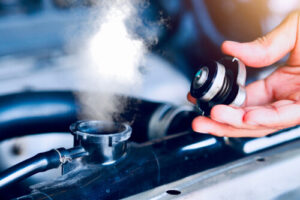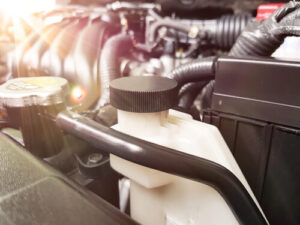If you ever shop around on craigslist for cheap cars as I do, it’s evident by the number of head gasket failures that proper cooling system maintenance is often overlooked. The cooling system on the average family hauler is a complicated beast, full of moving parts, plastics, harsh chemicals, rust, and minerals that can deposit, leaving its ability to do its job on the side of the road. That’s precisely where you can end up if you don’t keep track of at least a few things like your car ages. Winter is still lingering in the air, but it’s time to start thinking about fixing some common problems before that first hot day.
SAAB’s Coolant Bypass Valve
A widespread failure, especially among SAAB’s relates to the coolant bypass valve. The heater core in your dash receives engine coolant diverted from the main lines and feeds it through the back of the engine bay into the cabin. At this junction is a plastic or metal diverter valve that opens and closes based on demand from your heater.
A typical coolant bypass valve, this one out of a SAAB 9-5 can cause serious problems.
When the valve reaches its later years, it can get sticky, leaky, and in many cases, fail. The sign of which is often the owner returning to their car with a cart full of groceries, only to find a huge puddle of coolant under their car. Extreme failures can result in hot coolant spraying in the engine bay or the car. It varies from model to model, but if a coolant bypass valve has been installed for more than ten years or 100k mi, it is probably worth a change. It is a cheap job for peace of mind, what’s the point in waiting for a failure?
What About Water Pumps?
Water pumps nearly fall into the same category, although their signs of failure are usually fewer puddles and more heating. Some BMW’s, in particular, are plagued with plastic impeller water pumps that can wear and break prematurely. This can cause overheating and the potential head gasket/engine failure if the driver is not closely watching their temp gauge. You can upgrade cars with this style of the water pump that is possible to upgrade with metal pumps, which is an excellent job if you plan on keeping a car and is often cheap to do. A good time to change your water pump is when belts and pulleys are being serviced, as the engine’s serpentine belt almost always runs the pump. There are some exceptions with electric water pumps.

The Key Factor is Thermostat
The thermostat is a simple replaceable valve that closes to keep coolant from circulating in your engine while it warms up. This results in less time spent below optimum temperature, which your engine hates. When the thermostat ages, it can get sticky or fail to open completely. A sticky thermostat will keep coolant from circulating even after your car is warmed up, which can result in running hot and overheating in unfortunate circumstances. Many thermostats are built with fail-safes to stick open rather than closed, extending the time for engine warm-up drastically. Thermostats should be replaced around 60,000 miles to make sure it is always opening and closing correctly.
When the Last Time Your car had its Cooling System Flushed?
A contributing factor in the failure of some of these parts is corrosion deposits left by impurities in your coolant. Do you know when the last time your car had its system flushed? If it’s been more than a few years, your coolant can be working against you, becoming acidic, and eating away at your seals. The coolant itself can also become electrically conductive as the protective chemicals in its age. This can cause a sort of electrolysis effect when ground current begins to take coolant passageways instead of the metal in the block. This action erodes and pits water jackets and helps buildup, lessening the effectiveness of the system. Any seam or ridge can become havens for gunk buildup (like your bypass valve or thermostat). There are products that you can use during a coolant flush that can descale your system, unclog your radiator and heater core, and remove deposits. We have a Mercedes-Benz product in stock that does just this.
Using OEM Coolant System can Prevent Damage
An important point to mention is the coolant itself. Usually, the staff at the car parts store works just fine. However, many European car manufacturers specifically design their cooling systems with a specific coolant in mind. Using the wrong one can accelerate wear and cause premature leaks.
This is usually dependent on the type of metals used in the system. Older cars tend to use yellow metals like copper and brass, and the wrong coolant can eat these parts away. Luckily, we stock many OEM manufacturer coolants. You need to know for certain that the coolant you are flushing with is the right one for your engine.
Finally, when keeping a properly working cooling system maintained, the hoses, of course, cannot be overlooked. However, failure is much less likely than some of the other parts previously discussed. An easy way to test a hose is to squeeze it. If the hose is spongy, soft and squishy, you should replace it. The most common failure points are junctions where the diameter of the hose is reduced, causing a higher pressure situation. Have a quick inspection to make sure your hoses are all in good shape.

Follow the schedule in your owner’s manual and use your best judgment; it comes to all maintenance, but be especially careful about making sure your cooling system is up to the task. If not, the result can be more than just being stranded. You could be looking at repair bills in the thousands of dollars for labor alone, and no one wants that (well, save for your mechanic!).
If you are not sure which part is suited for your car, feel free to get in touch with eEuroparts customer support technicians who will take care of all your car’s needs!



